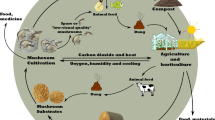Abstract
Cultivation of speciality mushrooms on lignocellulosic wastes represents one of the most economically and cost-effective organic recycling processes. Three species of Pleurotus, namely P. columbinus, P. sajor-caju and P. ostreatus were experimentally evaluated on untreated organic wastes including chopped office papers, cardboard, sawdust and plant fibres. Production studies were carried out in polyethylene bags of about 1 kg wet weight with 5% spawning rates of substrate fresh weight in a custom-made growth room especially designed for spawn run and cropping. The conversion percentage from dry substrate weight to fresh mushroom weight (biological efficiency) was determined. The highest biological efficiency was noted with P. columbinuson cardboard (134.5%) and paper (100.8%), whereas P. ostreatus produced maximum yield on cardboard (117.5%) followed by paper (112.4%). The overall yield of P. sajor-cajuwas comparatively low (range 47–78.4%). The average number of sporophore flushings ranged between 5 and 6 times. The findings that P. columbinus and P. ostreatus are superior to P. sajor-caju are consistent with previous reports elsewhere. Further evaluation of P. columbinus alone on different bagging systems containing partially pasteurized office papers as a growing substrate revealed that polyethylene bags resulted in 109.4% biological efficiency in contrast to pottery (86%), plastic trays (72%) or polyester net (56%). The above findings reveal an opportunity for commercial implication of oyster mushroom especially P. columbinus for utilization of different feasible and cheap recyclable residues.
Similar content being viewed by others
References
M.A. Ahmed (1994) Cultivation of Oyster Mushroom EditionNumber1 Comet Co. Cairo, Egypt 63
K.A. Azizi T.R. Shamala K.R. Sreekantiah (1990) ArticleTitleCultivation of Pleurotus sajor-caju on certain agro-industrial wastes and utilization of the residues for cellulose and d-xylanase production Mushroom Journal for the Tropics 10 21–26
P. Bajpai (1997) ArticleTitleMicrobial xylanolytic enzyme system: properties and applications Advances in Applied Microbiology 43 141–194 Occurrence Handle9097414
Z. Bano M.N. Shasirekha S. Rajarathnam (1993) ArticleTitleImprovement of the bioconversion and biotransformation efficiencies of the oyster mushroom (Pleurotus sajor-caju) by supplementation of its rice straw with oil seed cakes Enzyme and Microbial Technology 15 985–989
P. Bobek O. Ozdin M. Mikus (1995) ArticleTitleDietary oyster mushroom (Pleurotus ostreatus) accelerates plasma cholesterol turnover in hypercholesterolaemic rats Physiological Research 44 287–291 Occurrence Handle8869262
P. Bobek L. Ozdin S. Galbavy (1998) ArticleTitleDose- and time-dependent hypercholesterolaemic effect of oyster mushroom (Pleurotus ostreatus) in rats Nutrition 14 282–286 Occurrence Handle9583372
J.A. Buswell Y.J. Cai S.T. Chang J.F. Peberdy S.Y. Fu H.S. Yu (1996) ArticleTitleLignocellulolytic enzyme profiles of edible mushroom fungi World Journal of Microbiology and Biotechnology 12 537–542
C. Cangy A. Peerally (1995) ArticleTitleStudies of Pleurotus production on sugarcane bagasse African Journal of Mycology and Biotechnology 3 67–79
R. Cohen L. Persky Y. Hadar (2002) ArticleTitleBiotechnological applications and potential of wood degrading mushrooms of the genus Pleurotus Applied Microbiology and Biotechnology 58 582–594 Occurrence Handle11956739
Hossain, S., Hashimoto, M., Choudhury, E., Alam, N., Hussain, S., Hasan, M., Choudhury, S. & Mahmud, I. 2003 Dietary mushroom (Pleurotus ostreatus)ameliorates atherogenic lipid in hypercholesterolaemic rats. Clinical and Experimental Pharmacology and Physiology30, 470
R.A. Kurtzman SuffixJr. (1994) Nutritional needs of mushrooms and substrates M.C. Nair G. Gopalapalan D. Lulu (Eds) Advances in Mushroom Biotechnology Scientific Publishers Jodhpur 106–110
V. Mehta J.K. Gupta S.C. Kaushal (1990) ArticleTitleCultivation of Pleurotus floridamushroom on rice straw and biogas production from the spent straw World Journal of Microbiology and Biotechnology 6 366–370
Patil, B.D. & Jadhav, S.W. 1991 Yield performance of Pleurotus sajor-caju on various substrates. In Indian Mushrooms.Proceedings of National Symposium on Mushrooms. pp. 84–86. Thiruvanathapuram, India: Kerala Agricultural University.
T.H. Quimio S.T. Chang D.J. Royse (1990) ArticleTitleTechnical guidelines for mushroom growing in the tropics F.A.O. Plant production and Protection 106 62–70
A. Remtulla (1993) ArticleTitleUtilization of lignocellulosic residues for the cultivation of Pleurotus sajor-caju McIlvainea 11 40–43
D.J. Royse (1992) ArticleTitleRecycling of spent shiitake substrate for production of the oyster mushroom Pleurotus sajor-caju Applied Microbiology and Biotechnology 38 179–182
A. Sanchez F. Ysunza M. Beltran-Gracia M. Esqueda (2002) ArticleTitleBiodegradation of viticulture wastes by Pleurotus:a source of microbial and human food and its potential use in animal feeding Journal of Agricultural and Food Chemistry 50 2537–2542 Occurrence Handle11958618
S. Saxena R.D. Rai (1992) ArticleTitleEffect of nitrogen on production of extracellular degradative enzymes by Pleurotus sajor-caju (Fr.) Singer on wheat straw Mushroom Research 1 45–48
S. Sharma M. Madan (1993) ArticleTitleMicrobial protein from leguminous and non-leguminous substrates Acta Biotechnologica 13 131–139
A.K. Singh (1998) ArticleTitleCultivation of oyster mushroom (Pleurotusspp.) on sugarcane residues Journal of Mycology and Plant Pathology 28 24–245
C. Soto-Velazco I. Alvarez (1995) ArticleTitleFruit body production of Pleurotus spp. on sugarcane bagasse after treatment with sodium hydroxide African Journal of Mycology and Biotechnology 3 61–66
G.V. Thomas S.R. Prabhu M.Z. Reeny B.M. Bopaiah (1998) ArticleTitleEvaluation of lignocellulosic biomass from coconut palm as substrate for cultivation of Pleurotus sajor-caju (Fr.) Singer World Journal of Microbiology and Biotechnology 14 879–882
F. Zadrazil R.H. Kurtzman SuffixJr. (1982) The biology of Pleurotus cultivation in the tropics S.T. Chang T.H. Quimio (Eds) Tropical Mushrooms, Biology, Nature and Cultivation Methods The Chinese University Press Hong Kong 277–298
Author information
Authors and Affiliations
Corresponding author
Rights and permissions
About this article
Cite this article
Mandeel, Q.A., Al-Laith, A.A. & Mohamed, S.A. Cultivation of oyster mushrooms (Pleurotus spp.) on various lignocellulosic wastes. World J Microbiol Biotechnol 21, 601–607 (2005). https://doi.org/10.1007/s11274-004-3494-4
Issue Date:
DOI: https://doi.org/10.1007/s11274-004-3494-4




